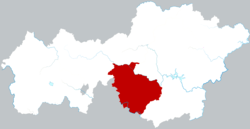Nayong County
Nayong County (simplified Chinese: 纳雍县; traditional Chinese: 納雍縣; pinyin: Nàyōng Xiàn) is a county in the west of Guizhou province, China. It is under the administration of Bijie city. It is rich in natural resources: coal, lead, zinc, marble, sulfur, iron, fluorite, dolomite, limestone and others. A significant portion of Guizhou's coal production is extracted in Nayong.[1] Nayong's marble is famous in China, and the annual production is 1,400,000 cubic metres (49,000,000 cu ft).[2] For agriculture, timber, tobacco, walnut and tea are some products of importance. In 2016, the total GDP was CN¥ 18,900,000,000, with a GDP per capita of CN¥ 27,843.
Nayong County 纳雍县 | |
|---|---|
County | |
 Nayong in Bijie | |
.png) Bijie in Guizhou | |
| Coordinates (Nayong County government): 26°46′45″N 105°24′53″E | |
| Country | People's Republic of China |
| Province | Guizhou |
| Prefecture-level city | Bijie |
| Area | |
| • Total | 2,452.32 km2 (946.85 sq mi) |
| Population (2016)[1] | |
| • Total | 1,081,429 |
| • Density | 440/km2 (1,100/sq mi) |
| Time zone | UTC+8 (China Standard) |
Administrative divisions
Nayong is partitioned in the following town-level divisions:[3]
- Yongxi subdistrict (雍熙街道)
- Wenchang subdistrict (文昌街道)
- Juren subdistrict (居仁街道)
- Zonglin town (骔岭镇)
- Shaowo town (勺窝镇)
- Yangchang town (阳长镇)
- Xinfang township (新房乡)
- Weixin town (维新镇)
- Dongdi township (董地乡)
- Shedongguan township (厍东关乡)
- Longchang town (龙场镇)
- Zhaile town (寨乐镇)
- Huazuo township (化作乡)
- Lezhi town (乐治镇)
- Yulongba town (玉龙坝镇)
- Shabao town (沙包镇)
- Shuidong town (东镇)
- Baixing town (百兴镇)
- Shuguang town (曙光镇)
- Gukai township (姑开乡)
- Guoquanyan township (锅圈岩乡)
- Yangchang township (羊场乡)
- Kunzhai township (昆寨乡)
- Zhuchang township (猪场乡)
- Zuojiujia township (左鸠戛乡)
- Zhangjiawan town (张家湾镇)
Climate
| Climate data for Nayong (1981−2010) | |||||||||||||
|---|---|---|---|---|---|---|---|---|---|---|---|---|---|
| Month | Jan | Feb | Mar | Apr | May | Jun | Jul | Aug | Sep | Oct | Nov | Dec | Year |
| Record high °C (°F) | 23.5 (74.3) |
30.1 (86.2) |
34.1 (93.4) |
33.4 (92.1) |
33.9 (93.0) |
33.2 (91.8) |
33.0 (91.4) |
32.6 (90.7) |
32.9 (91.2) |
28.9 (84.0) |
26.9 (80.4) |
22.1 (71.8) |
34.1 (93.4) |
| Average high °C (°F) | 7.7 (45.9) |
10.1 (50.2) |
15.2 (59.4) |
19.9 (67.8) |
22.9 (73.2) |
24.5 (76.1) |
26.6 (79.9) |
26.5 (79.7) |
23.5 (74.3) |
18.3 (64.9) |
14.8 (58.6) |
10.0 (50.0) |
18.3 (65.0) |
| Daily mean °C (°F) | 3.9 (39.0) |
5.8 (42.4) |
9.9 (49.8) |
14.6 (58.3) |
17.9 (64.2) |
20.1 (68.2) |
21.9 (71.4) |
21.4 (70.5) |
18.5 (65.3) |
14.4 (57.9) |
10.4 (50.7) |
5.8 (42.4) |
13.7 (56.7) |
| Average low °C (°F) | 1.6 (34.9) |
3.2 (37.8) |
6.4 (43.5) |
10.9 (51.6) |
14.3 (57.7) |
17.0 (62.6) |
18.7 (65.7) |
17.9 (64.2) |
15.3 (59.5) |
11.8 (53.2) |
7.6 (45.7) |
3.1 (37.6) |
10.6 (51.2) |
| Record low °C (°F) | −7.6 (18.3) |
−4.8 (23.4) |
−4.3 (24.3) |
0.6 (33.1) |
4.8 (40.6) |
9.4 (48.9) |
9.3 (48.7) |
10.8 (51.4) |
6.2 (43.2) |
2.4 (36.3) |
−3.3 (26.1) |
−7.5 (18.5) |
−7.6 (18.3) |
| Average precipitation mm (inches) | 28.1 (1.11) |
26.6 (1.05) |
32.9 (1.30) |
69.2 (2.72) |
146.1 (5.75) |
218.3 (8.59) |
218.0 (8.58) |
166.1 (6.54) |
139.7 (5.50) |
97.3 (3.83) |
39.2 (1.54) |
21.4 (0.84) |
1,202.9 (47.35) |
| Average relative humidity (%) | 86 | 84 | 78 | 77 | 77 | 81 | 79 | 80 | 80 | 84 | 83 | 83 | 81 |
| Source: China Meteorological Data Service Center | |||||||||||||
Demographics
The total population is a little over 1 million people as of 2016 with a male to female ratio of 1.07:1. The urban population was 242,379 people. Nayong is home to at least 29 ethnic minorities such as Miao, Yi, Bai, Buyi, Hui, Dong and Zhuang.[1]
Transportation
Nayong has a railway station on the Zhijin to Liupanshui railroad, which was completed in 2015.[4]